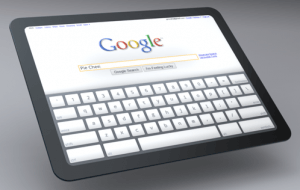In its search for new markets and revenue, Google seems to be taking a bite out of Apple.
For months the two companies have competed in the mobile-phone market thanks to Google’s Android operating system, and that competition is fiercer now that Google has stamped its logo on the back of the Nexus One (designed by Google and manufactured by HTC). Despite some differences, the new Google smartphone looks a lot like an iPhone.
There’s competition on other fronts as well, including the operating system business.
In its initial blog post in July, Google positioned Chrome OS as “an open source, lightweight operating system that will initially be targeted at netbooks.” That alone could harm Apple if Chrome-powered netbooks take sales away from Mac laptops. But now there’s talk about both Chrome and Android being used on tablet devices that could compete with Apple’s just announced iPad.

There have been no product announcements, but Google’s Chrome Web site is displaying “visual explorations of how a Chrome OS tablet UI (user interface) might look in hardware.” The illustrations provide only a vague idea of what such a tablet might be like, but their very existence indicates that Google may be eyeing the market that Apple hopes to bust open.
Just in case one tablet operating system isn’t enough of a threat to Apple, Google is potentially going after the iPad with two operating systems at once. Android, in addition to Chrome, could also be used to create a potential iPad killer.
At last month’s Consumer Electronics Show, MSI displayed a 10-inch tablet running Google’s Android operating system.
It’s important to emphasize that neither the Google concept drawings nor the MSI prototype represents a real product. But what they do represent is the possibility, and perhaps the intention, of Google to quickly enter the tablet marketplace.
To be sure, there are important differences between Apple and Google. Apple is more focused and disciplined — it works long and hard on a very small number of products and keeps quiet about them until they’re almost ready for prime time. Then, with great fanfare, Steve Jobs announces them to the world and puts them on sale shortly thereafter.
Google throws lots of things against the wall to see what sticks. The company’s experimental culture is so strong that employees are allowed to devote 20 percent of their time to any project that strikes their fancy, some of which actually see the light of day as products or services.
Apple’s formula — at least with the iPhone — worked like a charm. The hype was followed by a product that delighted most early reviewers and customers. And although I questioned in last week’s column whether the iPad can live up to its hype, I acknowledge that it is an innovative product that might do well when it hits the market.
Google’s approach is usually to pre-announce months in advance and rely on partners like HTC (and now Motorola) to build devices around its open source software. Unlike the first iPhone, the initial Android phone — the HTC G1 — got tepid reviews. But with the release of the Motorola Droid and Google’s Nexus One, Android is starting to win fans and respect.
Google’s initial foray into the browser market was also a bit disappointing but that, too, is starting to change. When the Chrome browser came out, it was a bit faster than market leaders Internet Explorer and Firefox but not nearly as versatile because it lacked support for extensions that allow third parties to add functionality. However, Google recently released a beta version of Chrome that fixes that problem.
Last month Chrome overtook Apple’s Safari as the third-place browser behind Internet Explorer and Firefox, according to Net Applications. As more extensions become available and more people download the newer version, I’m confident its market share will continue to grow.
The biggest difference between Apple and Google has to do with control. Apps for both the iPhone and iPad will be distributed through Apple and be vetted and approved by Apple before being made available to users. Google has a more open approach, allowing anyone to create an app for their phone or their computer operating system.
The democrat (small d) in me sides with Google. But the part of me that’s concerned about safety and security understands the advantages of having a company like Apple examine the applications for its devices.
Mostly I’m just glad to see these two talented and resourceful companies compete with each other and, of course, Microsoft, which was once thought to be a monopoly but is now struggling to compete with both Google and Apple.
This post is adapted from a column by Larry Magid that appeared in the San Jose Mercury News

Be the first to comment